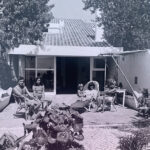Exploring one of the Algarve’s historic Easter processions
“Ressuscitou como disse! Aleluia, Aleluia, Aleluia!”
(He is risen as he said! Alleluia, Alleluia, Alleluia)
Easter is arguably the most important date in the Christian calendar. It not only marks the trial, crucifixion and resurrection of Christ, but it also unofficially marks the beginning of Spring and the warmer months ahead.
With a strong Catholic influence in Portugal, it’s no surprise that many towns and villages pull out all the stops for a celebration such as Easter. This is especially evident in the town of São Brás de Alportel, which has had close links with the Catholic church throughout much of its long and varied history.
The town was named after St. Blaise (Brás) – a martyred bishop living in Armenia between the third and fourth centuries. He was born in Rome in c. 264 and gained wider recognition after removing a thorn from a child’s throat after offering prayers. This miracle would later lead to his patronage as the Patron Saint of diseases. St. Blaise was captured by the Romans and beheaded in c. 316 in Sebaste, Armenia, under the Roman Emperor Licinius and became the Patron Saint of São Brás de Alportel here in the Algarve with both the town and parish church dedicated to his memory.

During the 17th century, São Brás de Alportel became the summer residence of the Algarvian bishops, who built an Episcopal palace near Jardim da Verbena to escape the summertime heat. Today the only remnant of the former clerical palace is a Baroque fountain that once graced the gardens. However, one historic annual event that has not been forgotten is the Festa das Tochas Floridas (The Festival of Flower Torches), which takes place every Easter Sunday, celebrating the resurrection of Christ.
During the lead-up to Easter, the town’s small cobbled roads are transformed into a carpet of flowers and shrubs arranged in a floral mosaic display. They form a carpet for the grand procession, where villagers armed with torches of various floral bouquets follow the shroud-covered Host, (the name given to the holy bread once blessed). They process from the Parish Church of São Brás (Igreja Matriz), along Largo de São Sebastião and around the village, trampling on top of the ornate carpet of flowers. To some, it may seem awful to ruin such a beautiful display, but let’s not forget that such elaborate displays are seen as a gift to God rather than for us to look at. However, the spectacle of the flowers is why many, including myself, come from far and wide to see this traditional Algarvian event year after year.
Often referred to as the Alleluia Procession, deriving from the ancient Easter greeting “The Lord is risen indeed, alleluia!” as noted in Luke 24:34, which is chanted throughout the entire procession, the origins of the festival itself seems to have been lost in time.
Some say that the Festa das Torchas Floridas dates back to the expulsion of English invaders led by the Earl of Essex in 1596. The villagers of São Brás processed through the town in jubilation when the Parish church was recovered after being burned to the ground and looted by the invaders during the Anglo-Spanish war. However, others say that the procession was introduced by the church in 1731 when Bishop of the Algarve, Cardinal Dom José de Santa Susana wished to commemorate the Faith and the Resurrection of Jesus Christ. Whatever the origins, the Festa das Torchas Floridas has been delighting locals and visitors for centuries.



Since the early days, many parishes across the Algarve had their own version of the Easter Sunday procession. Originally, the confraternities (the lay people of the Renaissance and early modern Catholic Church) were obliged to carry a lighted torch or lamp and clothed opas, similar to a priest’s cloak. However, at some point, the lack of wax led to the appearance of painted sticks, decorated with flowers, on top of which a small candle was placed and thus was born the Torchas Floridas (flower torches), which are still used today. Whilst many towns and villages hold processions to celebrate Easter Sunday, São Brás de Alportel arguably remains the most popular.
In recent decades the local parish has held competitions to judge the best flower torches and decorated balconies. Local support for the event has increased and partnerships with the Associação Cultural Sambrasense, the City Council, and the voluntary support of various associations in the community have kept this annual celebration alive. Thousands now come to this small sleepy town to celebrate the resurrection of Christ.
If you’re looking for something to do this Easter Sunday, why not head over to São Brás de Alportel? Or, if that’s too far, maybe join in with your local community’s Easter parade and experience some local history.
The floral street display opens at 9.30 am – Sunday, 9 April, with the Easter Sunday Eucharist of the Resurrection Service taking place at the Parish Church (Igreja Matriz de São Brás de Alportel) at 10 am, followed by the Procession throughout the town at 11 am. There is also usually a Sunday Eucharist held afterwards at 1pm.
Photos © Luka Alexander circa. 2010
Black and white photos © Câmara Municipal de São Brás de Alportel













